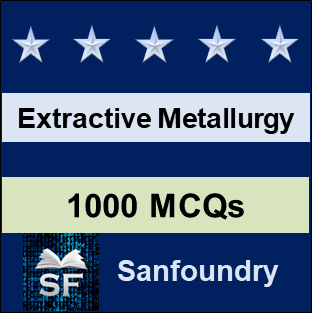Here are Extractive Metallurgy MCQs (Chapterwise).
1. What is extractive metallurgy?
a) The process of refining metals after extraction
b) The process of extracting minerals from the Earth
c) The process of extracting metals from ores
d) The process of converting metals into alloys
View Answer
Explanation: Extractive metallurgy is focused on the extraction of metals from their naturally occurring sources, known as ores. The process typically includes various steps such as crushing, grinding, and applying specific techniques like smelting or leaching to separate the desired metal from the ore.
2. Which of the following is not a common method used in extractive metallurgy?
a) Electroplating
b) Pyrometallurgy
c) Hydrometallurgy
d) Smelting
View Answer
Explanation: Electroplating is not a common method used in extractive metallurgy. Extractive metallurgy typically involves processes such as smelting, hydrometallurgy, and pyrometallurgy to extract metals from their ores. Electroplating, on the other hand, is a surface coating process where a metal is deposited onto a conductive object through the use of an electric current.
3. What is leaching in the context of extractive metallurgy?
a) The process of melting ore to extract metal
b) The process of separating metals based on their melting points
c) The process of shaping metals through mechanical deformation
d) The process of dissolving a metal from its ore using a liquid solvent
View Answer
Explanation: Leaching involves the use of a liquid solvent to dissolve metals from their ores. This process is often applied to extract valuable metals from low-grade ores.
4. Which among the following is the place of extraction of Galena in India?
a) Gujarat
b) Jharkhand
c) Orissa
d) Andhra Pradesh
View Answer
Explanation: Galena has the chemical composition of lead sulphide (PbS). It is hugely extracted in Gujarat, Haryana in India.
5. Which of the following processes is not a part of Pyrometallurgy?
a) Roasting
b) Calcination
c) Leaching
d) Smelting
View Answer
Explanation: Leaching is a Hydrometallurgical process. The three main processes of Pyrometallurgy are calcination, roasting and smelting.
6. What type of agent can speed up a roasting process?
a) Volatile oxide
b) Roaster
c) Electrolyte
d) Catalyst
View Answer
Explanation: Catalyst is a substance or an agent which increases the rate of a reaction. It is non-consumable. During the roasting process, Quartz is one of the catalysts which can be used.
7. When is it better to use a selective distillation process?
a) The process is very cheap
b) Impurities are more volatile than metal
c) Impurities are less volatile than metal
d) Amount of impurities is more than metal
View Answer
Explanation: The selective distillation process can be usually applied when the impurities are more volatile than the metals. It lowers the power required for heating. This is not compulsorily applied in every distillation process.
8. Which of the following is not a step involved in a hydrometallurgical process?
a) Electrowinning
b) Separation of leach liquor
c) Leaching
d) Reagent recovery
View Answer
Explanation: The steps involved in a hydrometallurgical process are leaching, separation of leach liquor, recovery of metals from leach liquor and recycling of leach liquor. Electrowinning is an electrometallurgical process.
9. What is the role of a reducing agent in the extraction of metals?
a) To oxidize the metal
b) To increase the metal’s melting point
c) To remove impurities from the ore
d) To donate electrons and reduce metal compounds to metals
View Answer
Explanation: In the extraction of metals, a reducing agent plays the crucial role of providing electrons to reduce metal compounds into their elemental form. Reduction is a chemical reaction in which electrons are gained, and this process helps convert metal oxides or other compounds into the pure metal. The reducing agent itself is oxidized in the process.
10. In which step of extractive metallurgy is the concentration of ore typically carried out?
a) Refining
b) Smelting
c) Roasting
d) Crushing and Grinding
View Answer
Explanation: In the extraction of metals, a reducing agent plays the crucial role of providing electrons to reduce metal compounds into their elemental form. Reduction is a chemical reaction in which electrons are gained, and this process helps convert metal oxides or other compounds into the pure metal. The reducing agent itself is oxidized in the process.
11. Why roasting is done in the copper extraction process?
a) To remove phosphorus from the concentrate
b) To remove Sulphur from the concentrate
c) To increase the copper content
d) To make the copper extraction process faster
View Answer
Explanation: The roasting in the copper extraction process is done to remove the Sulphur from the concentrate. Roasting is also done to partially oxidize iron sulphide which is present with copper sulphide. This facilitates its removal further in the smelting operation.
Chapterwise Multiple Choice Questions on Extractive Metallurgy

- Extractive Metallurgy Basics
- Methods of Extraction and Refining of Metals
- Thermodynamics of Metallurgical Reactions
- Hydrometallurgy
1. MCQ on Extractive Metallurgy Basics
The section contains multiple choice questions and answers on natural occurrence of metals and mineral dressing.
|
|
|
2. Methods of Extraction and Refining of Metals
The section covers questions and answers on various aspects of Extractive Metallurgy, including pyrometallurgy, calcination, roasting, smelting, unit processes for metal extraction, and extraction of metals from sulphide ores. It also discusses pyrometallurgical processes under different pressures, along with distillation and refining.
3. Thermodynamics of Metallurgical Reactions
The section contains Extractive Metallurgy MCQs on thermodynamic and chemical equilibrium.
|
|
|
4. Extractive Metallurgy Questions on Hydrometallurgy
The section contains multiple choice questions and answers on the advantages and disadvantages of hydrometallurgy, leaching reagents, techniques, and kinetics. It also covers leach liquor purification and applications of hydrometallurgy.
|
|
|
Wish you the best in your endeavor to learn and master Extractive Metallurgy!
If you find a mistake in question / option / answer, kindly take a screenshot and email to [email protected]
